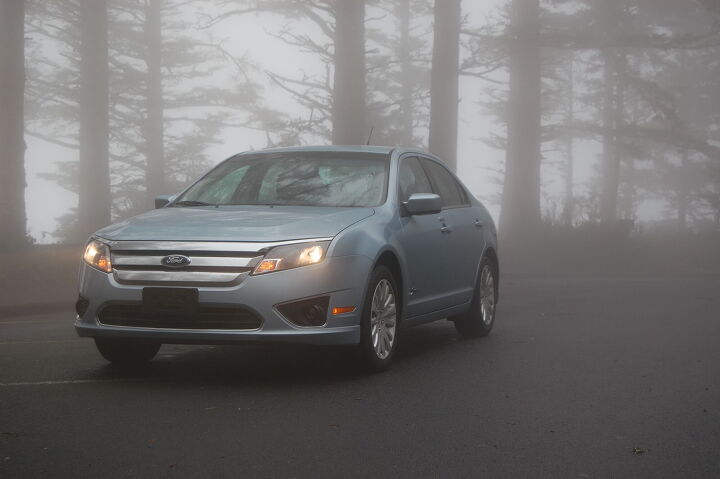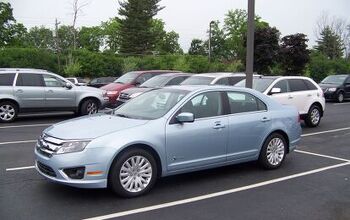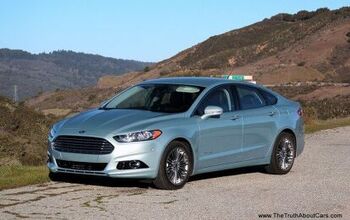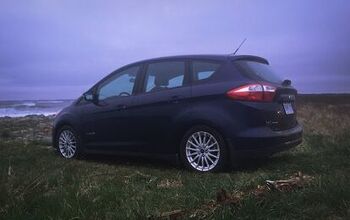Review: Ford Fusion Hybrid
At the risk of sounding older and crankier than I feel, it can be hell trying to find a car with a unique identity anymore. As our four-wheeled friends have become more refined, they’ve also become more homogeneous. Especially when sampling mass-market sedans, the distinctions are often subtle to the point of solipsism, and a sense of automotive deja vu is almost inescapable. Which is why there’s a surprisingly warm place in my heart for hybrids: they may not be fun or even practical in the traditional senses, but they are undeniably different. Unless, of course, they aren’t.
Which is not to say that the Fusion’s hybrid powertrain can’t be used for less socially harmonious pursuits. Leaving the traffic behind and heading into Oregon’s coast range, the road begins to wind and the commuter daze fades somewhat. After soft-shoeing the gas accelerator for miles, a savage jab at the throttle feels like a satisfyingly guilty pleasure. There’s a brief pause while the eCVT transmission process the right foot’s environmentally irresponsible request before the sound of burning hydrocarbons heralds a noticeable surge of power. The drivetrain transitions are surprisingly smooth, and progress down the road is pleasantly satisfying (0-60 in about 8.5 seconds).
The Fusion’s respectable poke and planted feel might almost make you look forward to the really curvy bits of road. And it keeps feeling poised and capable until the moment that you start to turn the wheel, and all you can feel is 3,800 pounds pulling you wide. A dab on on the regenerative brakes brings the nose into line, but by then the promise of any kind of fun has passed. Adding to the questionable at-speed handling is the (repeat after me) numb, overboosted power steering. Vague on-center, the helm goes completely numb in sweeping curves that might otherwise be worth a redeeming giggle. And though body roll is quite well-contained, mid-sweeper bumps are exaggerated by the oversensitive yet uncommunicative wheel, requiring awkward mid-corner correction.
But the reality is that nobody buys a hybrid based on winding mountain road performance. Besides, there’s nothing terrifying or dangerous about the Fusion Hybrid’s handling dynamics, it simply never feels like mucking about. Luckily, the brief attempt at traditional car fun has helped shed some light on the keys to the Fusion’s hybrid hypnosis. One of the Fusion’s party tricks is its ability to run on electric power alone up to 47 mph, nearly twice the speed where its foreign competitors switch to a gas-electric mix. Unfortunately, realizing this advantage requires the combination of a full battery, compliant traffic and right-foot reflexes of Swiss watch precision.
The Fusion’s other unique offering to the hybrid repertoire is the control panel’s brightly-colored LCD display, which turns humdrum commutes into an eco-themed video game. In the “Empower” display setting, the right edge of the gauge screen is occupied by a kind of leafy digital vine which grows as you drive more efficiently. In concert with a power-demand gauge, this tritely metaphorical aide lends a weird glamor to light-footed driving. Though watching your botanical nanny shrivel under unrelenting acceleration adds a certain amount of palate-cleansing schadenfreude to the hybrid experience, the thrills never last and you always end up settling back into a quasi-hypermiling driving style. If ever there were a way to keep the Playstation generation from living out Gran Turismo fantasies on public roads, this is it.
Unfortunately, as it is with so many other instances of 21st Century life, the video game is better than reality. Though the Fusion Hybrid is rated at 41 mpg city and 36 mpg highway, our tester averaged 35.5 mpg over 600 miles of mixed driving. Sure, the majority of our testing was outside of stop-start urban traffic, but most of it was also driven with efficiency in mind (and a little research shows that we weren’t the only testers to struggle to replicate the Fusion’s EPA numbers in the real world). Overall, that’s not much better than what you might expect from a Fusion S, which starts under $20,000 compared to our stripper Hybrid’s $27,270 MSRP. Which is a far more reasonable price point for such Fusion features as the cheesily chromed-out grille, and an interior that comes in any style you like as long as it’s at least 80 percent leather-grained, semi-soft black plastic.
Ultimately then, the Fusion Hybrid is a difficult car to recommend. A carefully-driven four-pot Fusion will come close to the Hybrid’s real-world efficiency numbers for less money, and offering more potential for old-school driving fun. Unless of course your commute is a traffic-ridden hell that involves more sitting than actual driving. Or unless money is no object and you want to show your support for the environment, a US company and the workers of Saltillo, Mexico, all at the same time.
For more rational commuters, a Prius offers more efficiency at a lower price, with less rear-seat room as the only relevant drawback. Oh, and one more thing: though the Fusion’s higher EV speed and engaging display insidiously sucks you into the hybrid lifestyle (aka life in the slow lane), once you wrestle your eyes away from the in-dash game the spell is broken and you’re left driving slowly in a cheap, heavy car. If Ford hopes to win more converts to the hybrid mystique, it will need to offer its otherwise competent drivetrain in a package that wears its uniqueness with pride. Aren’t modern cars homogeneous enough as is?
More by Edward Niedermeyer
Latest Car Reviews
Read moreLatest Product Reviews
Read moreRecent Comments
- Carrera I live in Florida and owned summer tires once before on a Corolla. Yes I know, it's a Corolla but it drove much better ( to me) with those on. I would have bought them again but replacement time came during the beginning of the " transitory inflation" and by then, I found all seasons that were much cheaper. Currently I own a slightly more performance oriented Acura TLX -AWD and when the OEM all season Michelin wear out, I will replace them with summer Michelins. Often times, a car comes alive with summer tires but I understand why people don't buy them above South Carolina. I lived in Canada for 5 years and just thinking about swapping twice per year made me anxious.
- Steve Biro I don’t bother with dedicated summer or winter tires. I have no place to store them. But the newest all-weather tires (with the three-peak mountain symbol) are remarkably good year-round. The best of them offer 90 percent of the performance of winter tires and still fall mid-pack among summer ultra-high performance tires. That’s more than enough for my location in New Jersey.
- Carfan94 Never, it doesn’t get cold eneough here in TN, to switch to winter tires. But it gets cold enough that running Summer tires year round is impractical. I’m happy with my All seasons
- Analoggrotto Anyone who has spent more than 15 minutes around a mustang owner would know this will be in insta-hit.
- Akear If this is true then they won't go out of business. Good for them!





































Comments
Join the conversation
The leafy vine graphic seriously grows when your driving is more "eco-friendly"? Who comes up with this crap?
I think y'all are overestimating the mileage of the ICE Fusion's I-4 -- or any large-displacement I-4. My Mazda3 has essentially the same engine, and despite weighing less and having a manual transmission, it barely cracks 30mpg on the highway. And in town? Fuhgeddaboudit. And even mileage champs like Toyota struggle to break out of the teens when hauling a mid-size car around town with a 4-cylinder. It's disturbingly common, this wild overestimation of ICE efficiency in articles and comments about hybrids. Mileage in the very high 30s is damned respectable for any car under any conditions, and for a midsized car in city driving? Unbelievably good. Give the Fusion Hybrid its due. Add to this the instant torque of an electric motor, and wow, great city car. No wonder cabbies buy 'em. Yes, a diesel also gets you strong torque and good efficiency, but even modern diesels shake, rattle and roll; their higher initial cost and higher ongoing fuel costs make them as dubious a cost-benefit gamble as any hybrid; and they spew deadly particulates (the exhaust from modern diesels LOOKS cleaner because the particulates are too small to see, but invisible-sized particulates are MORE deadly than visible ones--look it up). And searching for a truck stop just to fill up a car is a pain. Hybrids are here to stay. If you want one that's fun to drive, get a Nissan Altima instead. You give up some ride comfort and some MPGs for a more entertaining driving experience. The laws of physics and marketing have not been repealed: you can tune for efficiency or entertainment; Ford has chosen one niche and Nissan another, and it's as if your gripe is that it didn't make the same choices as Nissan, when doing so would only have lessened the hybrid's advantages and hence its market differentiation.